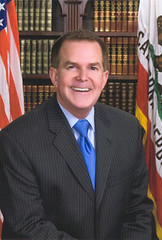Aren’t you excited that, with nearly two years until the next election, here I am offering campaign news?
Except there are two significant developments today in California of which you should be aware.
First, Jerry Brown is throwing his hat in the ring to be California’s governor for a second time. He hasn’t formally announced, but this interview signals that he will.
It was 1974 when Jerry Brown ran for governor as a dashing 36-year-old reformer, the embodiment of change in Watergate’s aftermath.
“I was the new spirit,” Brown recalled. “That was my slogan.”
No one would mistake Brown for a new spirit today. At 70, he occupies a prime spot among the elders of California politics. His career has spanned four decades, with three failed tries for the White House along his way up, down and back up the elective ranks.
Now, after two years as state attorney general, this Democrat who first ran for office in the era of Janis Joplin and the Beatles is remaking himself yet again. This time, Brown’s quest is to recapture the job he won 35 years ago: governor of California.
California doesn’t have a good history of Democratic candidates for Governor not named Brown over the last 50 years, so that alone is something. Brown has a lot to recommend him for the job and almost as much to reject him. He would be solid on the environment, energy and infrastructure but an absolute mess on prison policy. Right now, the field includes Gavin Newsom and John Garamendi, with several other possibles. If there’s a movement candidate on the horizon, I don’t see him or her.
The second development is that the DCCC, the campaign arm for Democrats in the House, has launched radio ads in 28 districts nationwide attacking House Republicans for their obstruction on the stimulus package.
The Democratic Congressional Campaign Committee (DCCC), chaired by Congressman Chris Van Hollen, today announced the DCCC is launching a Putting Families First ad and grassroots campaign in 28 targeted Republican districts. The ads focus on the Republicans out of step priorities by putting bank bail outs and building schools in Iraq before the needs of the Americans in the struggling economy. The Putting Families First ads begin airing on Tuesday morning during drive time and will run for a week.
In addition to the strategic radio ads in 28 Republican districts, the DCCC will also begin a grassroots initiative which includes targeted e-mails to 3 million voters and nearly 100,000 person-to-person telephone calls.
This is pretty early to be making such a move. And what’s very notable is the districts in California the D-Trip is hitting.
Representative Dan Lungren (CA-03)
Representative Elton Gallegy (CA-24)
Representative Ken Calvert* (CA-44)
Representative Brian Bilbray (CA-50)
CA-03 is an obvious choice, as it’s the most ripe district in the state for a turnover, and Bill Durston has already announced for a third run after his good showing in 2008. It’s good to see CA-44 get some action; Bill Hedrick came the second-closest in the state to defeating a Republican, and he’s running again. (The asterisk on that race means that they are actually using two separate ads in his district, one on children’s heath care and one on the bank bailout, so they’re actually targeting Calvert more than the others.) CA-50 is a perennial tease, with the Democrat never besting 46% against Brian Bilbray, but it’s just close enough to target.
The inclusion of CA-24 is interesting. We basically had no candidate there this time, as Marta Jorgensen spent pocket change to go against Elton Gallegly. She still managed 42% of the vote, showing that the floor for Democrats is fairly substantial. Gallegly has threatened retirement in the past and this is probably just pressure to get him to leave Congress. Perhaps the D-Trip knows of a good candidate waiting in the wings.
No CA-26, CA-46 or CA-04 on this list, probably because Debbie Cook, Russ Warner and Charlie Brown have made no indication that they’re running again.

 Nominee #1:
Nominee #1:  Nominee #2:
Nominee #2: